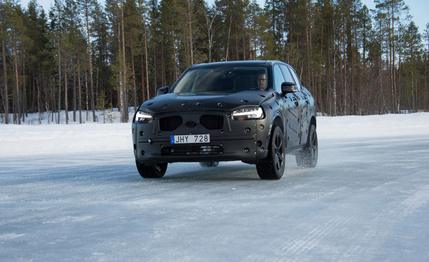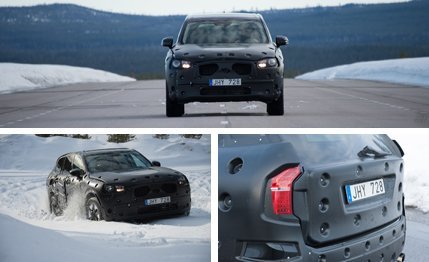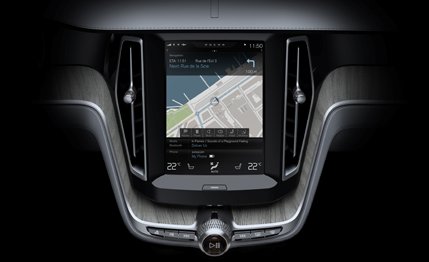
 First Ride
First Ride
The financial crisis might be receding into memory, but the lingering effects continue. Volvo, for one, was deeply affected by the downturn, as Ford jettisoned it during the depths of that American company’s problems. The Swedish automaker ended up being purchased by Geely, the up and coming Chinese company, and after several years of management churn, Volvo now seems to be on a stable path, with Swedish management in place and a considerable degree of independence.
For proof of the impact the fiscal turmoil had on Volvo, consider that the XC90 SUV, a stalwart of the lineup, is entering its 12th year of production. Some Japanese carmakers would have covered three model cycles in that time, and even the Germans would have done two. Finally, Volvo is prepping a new-gen XC90, which will go on sale in March of next year. And we just got a taste of the new machine.
We say “taste” because this was definitely not a typical press launch. We spent half a day with the car at a mysterious Volvo facility in northern Sweden, but all we were allowed to do was ride in it. We also weren’t permitted to publish photos of the car without its Rubbermaid-like camouflage.


But Volvo did let us see the undisguised version—and sit in it. The new ute has little in common with the now-hoary current XC90 and its comparatively tailored sheetmetal. Based on the design language introduced by a gorgeous trio of recent concept cars, the next-gen model is slick and smooth, with a high hoodline and an upright and bluff grille and front end. Volvo wanted to give the new model a more macho look, but it didn’t want the SUV to appear overly aggressive. So this XC90 lacks the old one’s wedgy profile. Its headlights are horizontal and narrow—a clear separation form the original’s large lighting units. Overall, the new soap-bar smooth XC looks a bit less distinctive than its predecessor at a time when competitive models are making strong visual statements, but it’s still handsome.
Inside, the new model moves in a unique, and characteristically Swedish, direction. In place of the platoons of buttons, switches, and knobs that line the central stacks and consoles of some Volvos, the XC90 has a central LCD screen above a single knob flanked by three buttons on each side—plus the start button adjacent to the steering column. It’s very much in the Bang & Olufsen “less is more” control philosophy, and it looks clean, elegant, and attractive.
Of course, how it works will depend on the intuitive performance of that LCD screen, and here again, Volvo has taken an unusual direction. Unlike every other automaker save Tesla, Volvo has positioned its 9.3-inch touch screen vertically and endowed it with iPad-like operation.

 The screen is essentially the same as this unit from the sexy Concept Estate.
The screen is essentially the same as this unit from the sexy Concept Estate.
The home screen has four horizontal summary layers—for navigation, audio/media, phone, and information. The HVAC controls are in a narrow band that’s always displayed at the bottom; as soon as you touch a control, the climate system takes over the whole screen to facilitate your inputs.
Otherwise, you can touch one of the four layers to expand it, while leaving narrower layers of the three others displayed on the screen. You can go full screen with any of the functions. You can pinch, expand, and swipe the screen to do various tasks, and these gestures deliver responses that are slick and smooth, just as they are on the best tablets. Swipe the entire screen to the side, and you access one of two lateral displays, again as on a tablet. One of them brings up a number of vehicle function buttons, which you can rearrange to suit your taste. The other provides access to any apps you have installed. We had only a few minutes to play with the system, but it operated without any of the hesitations or delays that often mar automotive touch screens. All the touch buttons are large, so they’re easy targets for your fingers. In addition, the XC90 will be among the first vehicles to offer Apple’s iOS CarPlay integration.
The portrait orientation of the touch screen is particularly beneficial to the navigation system because it helps you see more of what lies ahead, and it works well with the parking sensors, as it allows a large vertical display that mirrors the actual car orientation.
The front compartment promises to be finished to a high level, although the samples we saw weren’t fully to production spec. The bottom of the dashboard, and the top, are molded from soft plastic, and the parts of the console where your knees touch are upholstered in softer material. The center console has nice sliding covers to hide the requisite device and power outlets, as well as the cup holders—to maintain a “clean” design. But the storage under the armrest is not huge. On the other hand, the glove box is useful, as Volvo uses an electric latch to eliminate the mechanical-type units that steal space and scrunch papers.